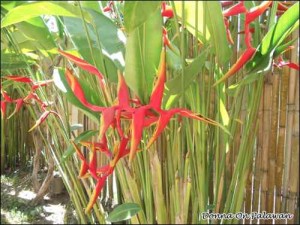Marston Matting – WWII Leftovers on Palawan
by Donna Amis Davis – @donnaamisdavis
Recently I was doing some research came across the official name of a common Philippine item. Everywhere you go in the Philippines, you see fencing made from this stuff:

It is called Marston matting. When we first arrived in the Philippines, more than 30 years ago, a veteran missionary pointed some fencing out to us and said it was leftover steel matting from World War II. We were amazed that it had survived 35 or 40 years in this rainy climate without rusting away. And now, it is 70 years since the start of World War II and this stuff is still around everywhere.
Here is the story. The material is made of plates of standardized, perforated steel, originally developed in by the U.S. before WWII primarily for the rapid construction of temporary runways and landing strips. The steel is made with a high manganese content to enable it to resist corrosion. Seabees could construct a runway 200 feet wide and 5000 feet long within 2 days by a small team of engineers using these mats. It is officially referred to as pierced (or perforated) steel planking, or PSP. But it came to be called Marston Matting (or sometimes Marsden Matting) because it was first manufactured adjacent to the town of Marston, North Carolina, not too far from modern Fort Bragg.

Huge quantities of the matting were produced, approximately 2 million tons. At the end of the war, a large amount of the material remained as war surplus, and was used in road and bridge construction and fencing.
You can still see fences made of the surplus matting in Puerto Princesa, especially in the older part of town, where the old WWII airstrip was located. We even found a cart made of it. Apparently, there are miles of fencing made of Marston Matting in Papua New Guinea, too, and it is found all over the islands of the Pacific, as well.
https://www.donnaamisdavis.com/marsden-wwii/Puerto Princesa & PalawanWorld War IIDonna Amis Davis,Palawan,Philippines,travel,Travel and Tourism,WWIIby Donna Amis Davis - @donnaamisdavis Recently I was doing some research came across the official name of a common Philippine item. Everywhere you go in the Philippines, you see fencing made from this stuff: It is called Marston matting. When we first arrived in the Philippines, more than 30 years...Donna Amis DavisDonna Amis Davis[email protected]AdministratorDonna Amis Davis

In Britain, during the Second World War the Government took steel structures from houses and public buildings, except schools, prisons and hospitals and used them to make weapons.
You often pass sandstone walls where the steel railings were cut off. My grandmother told me that there were some big beautiful houses where she lived in Motherwell with lovely railings which were cut down.
At least the Marston Matting was not made by destroying beautiful structures.
That is sad. It’s hard to imagine what it must have been like during those World Wars.
Hellish if you lived in the UK. Clydebank was badly bombed during the Second World War.
The Germans followed the route of the River Clyde to bomb Clydebank and my grandmother said you could hear and see the bombers nearly every night going over to bomb the town.
Food was rationed, everyone had a bomb shelter in their gardens and all windows had black our blinds. No lights were to be shown after dark in case the Germans were aided in bombing raids.
It was difficult to walk home at night in the dark as many people kept walking into things!
Women chased after American soldiers for chewing gum, chocolate and stockings as stockings were not available and women put tanning cream on their legs instead.
Food was rationed and everyone had a ration book. The American Government had to lend the British Government money as the war bankrupted the country.
Now look how ungrateful the Europeans are to the British after we defended them against the Germans.
All those railings were collected up for the war effort yet were made of such low quality cast iron as to be next to useless. Thousands of tons of these old railings were therefore dumped in the sea off Clacton. A complete waste of time, material and effort.
That’s too bad!
I wonder if they still make this stuff. It seems the Philippines has made some good use out of the materials we left here after the war…I bet with some of the more sturdy stuff many homes could be saved during the typhoons…might get flooded but left standing afterward…maybe…
I don’t know, but they sure aren’t bringing over to the Philippines by the ton anymore, are they?
Yes, the military still has similar material in inventory. Was used extensively in Vietnam for helicopter pads and airstrips at remote outposts – Its still called PSP with a dash designation to distinguish the particular type (solid and pierced depending on application)
Interesting! And why not — it’s versatile and durable.
I have been tapped on the shoulder to help build new Sheep yards on a friends property. Is also involved removing the old yards built of Maston Matting. I am planning on building s parking bay at my town house out of some of it
How cool to know that stuff is still out there being used for something!
Where is that home with the green painted fence? I want to drive over and see it.i live in Puerto Princesa now. Thanks for sharing.
It’s on Taft Street, not too far from Neva’s Place, though according to google maps, it looks like the fence is brown now. Interestingly, continuing down Taft toward the Cathedral, you can see several more Marston matting fences. I think the site of the old WWII runway must have been very close to there.